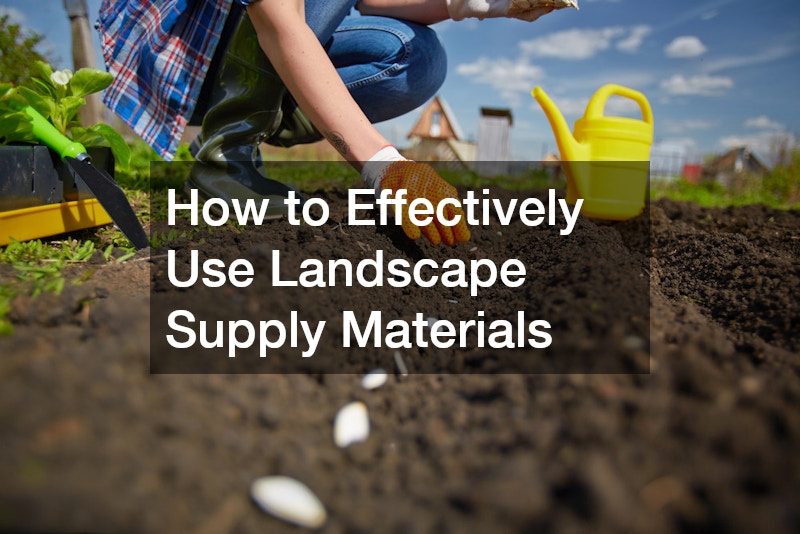Creating a well-designed outdoor space requires more than just vision—it calls for practical knowledge of how to utilise the right materials effectively. Whether you’re a homeowner improving your backyard or a landscaper working on a large-scale project, understanding how to handle and apply landscape supply materials is key to achieving a successful result. These materials form the foundation of a functional, aesthetically pleasing, and sustainable environment, enhancing everything from garden beds to walkways and retaining walls.
Start with a Detailed Plan
Before you make any purchases, it’s crucial to develop a clear plan of your landscaping goals. This includes mapping out the layout of your space, considering existing features, and identifying the functional zones—such as seating areas, paths, or garden beds. A detailed plan will help determine the types and quantities of landscape supply materials required, preventing unnecessary expenses or waste. For instance, knowing the measurements of an area needing mulch or gravel allows for accurate calculations and avoids over-ordering.
It’s also wise to research the soil condition, sun exposure, drainage patterns, and slope of the land. This information informs the selection of appropriate materials, such as choosing permeable pavers for areas prone to water runoff or selecting soil conditioners for poor soil quality. By planning ahead and taking environmental factors into account, you increase the likelihood of long-term success and reduce the risk of costly rework.
Select the Right Materials for Each Function
Different landscaping elements call for specific materials, and knowing how to match them to their purpose will determine both the visual impact and durability of the project. When using soil or compost, ensure you’re selecting blends suited to the plants you intend to grow. A premium garden mix works well for raised vegetable beds, while native gardens may benefit from sandier, low-nutrient soils. For pathways, crushed rock or gravel provides stability and excellent drainage, while pavers or stepping stones offer structure and a formal appearance.
Mulch is another essential landscape supply component. It helps regulate soil temperature, retain moisture, and suppress weeds. Organic mulches, such as bark or wood chips, decompose over time, enriching the soil. In contrast, inorganic mulches like pebbles or scoria offer a more decorative look and require less frequent replacement. Choosing the right mulch for the setting and applying it correctly—usually around 75 mm deep—ensures maximum benefit without smothering plant roots.
Hardscape materials such as retaining wall blocks, sleepers, and edging products add definition to a landscape while also serving functional purposes like erosion control. When using these, take care to follow installation guidelines, as proper alignment, footing depth, and drainage are vital for long-term stability.
Use Materials Efficiently and Sustainably
Efficient use of landscape supply materials doesn’t just save money—it also supports sustainability. Buy only what you need by calculating quantities based on the area’s dimensions and the coverage rate of the material. Many suppliers provide online calculators or staff assistance to help with estimates. Storing excess materials properly can also reduce waste, allowing unused gravel or pavers to be reused on future projects.
When possible, consider incorporating recycled or locally sourced materials. Recycled concrete aggregate, reclaimed timber, and recycled mulch are increasingly available and provide environmentally friendly options without compromising quality. Using permeable surfaces for paths and driveways encourages natural water absorption, reducing stormwater runoff and supporting the health of your garden.
Maintain and Refresh as Needed
Using landscape supply materials effectively also involves ongoing maintenance. Mulch needs to be topped up periodically as it breaks down, while gravel paths may require raking and levelling. Timber features may need oiling or sealing to protect against weather damage, and soil health should be monitored to ensure it continues to support plant growth.
Over time, even the most well-laid elements may need refreshing. Replacing faded pavers, re-edging garden beds, or switching out tired mulch for a fresh colour can revitalise the appearance of the landscape without requiring a full redesign. This not only boosts curb appeal but also ensures your outdoor space remains functional and enjoyable throughout the seasons.
Partner with Reputable Suppliers
Choosing a reputable supplier is essential when sourcing quality landscape supply materials. A professional supplier can offer guidance tailored to your needs, helping you select the most suitable products for your environment and project scope. Many also provide delivery services, saving you time and ensuring safe transport of bulk materials.
Look for suppliers who are transparent about the origin and composition of their products. This is particularly important for soils and mulches, where contamination with weeds or synthetic materials can compromise the integrity of your garden. A dependable supplier will also be able to offer advice on how to use each product most effectively, supporting your success from start to finish.
Building Success with the Right Materials
Using landscape supply materials effectively is about more than simply purchasing and placing them. It involves thoughtful planning, appropriate selection, efficient application, and ongoing maintenance. Whether you’re shaping a new garden or refreshing an existing space, these principles ensure your outdoor areas are both beautiful and practical. By partnering with reliable suppliers and making informed choices, you set the foundation for a thriving, sustainable landscape that continues to deliver value and enjoyment for years to come.

